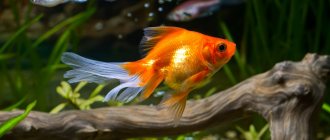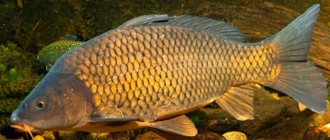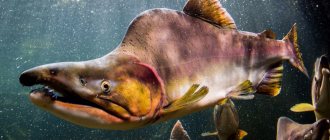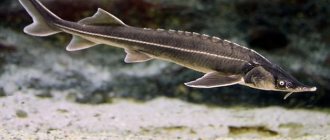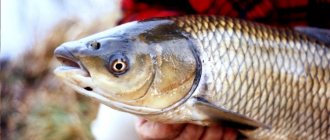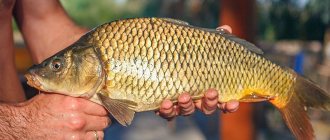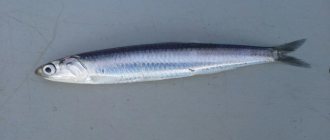Description
| Class: | Ray-finned fish |
| Squad: | Carp-like |
| Family: | Carp |
| Genus: | Carps |
| Scientific name: | Cyprinus |
| Homeland: | China and Southeast Asia |
| Habitats: | rivers, lakes, ponds |
| Nutrition: | omnivores |
| Weight: | average 1-5 kg, sometimes up to 50 kg |
| Lifespan: | 2-7 years, some live 50-100 years |
Carp are large freshwater fish. Among them there are predators, herbivores and omnivores. Carp is distinguished from other fish of this family, crucian carp and grass carp, by short antennae on the upper lip. Subspecies also differ from each other.
- River carp constantly have to fight the current to find food, so they are recognized by their elongated and elongated body and smaller size.
- Lakes and ponds are classified as closed reservoirs. The carp here are round in shape, quickly gain weight and are adapted to the lack of oxygen in the water.
Sarboyan carp
Sarboyan carp (authors of the breed: Korovin V.A. and Zybin A.S.). The first Siberian breed, approved in 1987. Bred in Western Siberia. Currently, it has proven itself well in other regions of the country. Belongs to the group of broad-backed carp. The ratio of height to length is 1:2.5-1:2.75. Head length no more than 1/5 body length. The scaly cover is continuous. It is distinguished by high fertility - 80-310 thousand larvae during natural spawning and more than 475 thousand during hatchery spawning.
Winter hardiness is high - no less than 94.5%. Spawning is observed even at temperatures below 16°C. Resistant to oxygen deficiency. During the short Siberian summer it is able to reach a standard weight, both at the fingerling and two-year stages. Pays well for growth with feed added to the water. Sarboyan carp has an admixture of blood from Amur carp and Ropsha carp. Currently, the breed has 3 types (layering): northern, Omsk and steppe.
Sarboyan carp video
Origin of carp
There are two opposing versions:
The first claims that the carp was bred artificially by Chinese breeders using the genetics of domesticated carp. That’s why the name is translated as “domesticated carp.” Over time, through river canals and thanks to transportation, a new type of fish populated the waters of Europe, and then came to America. This version is considered erroneous.
The second version says that wild carp have long been considered an inhabitant of rivers and lakes. And they settled more often lake inhabitants. New, artificial breeds based on this variety of carp have been developed over the past 150 years for the biological improvement of species diversity.
Altai mirror carp
Altai mirror carp was approved as a breed in 1994. Created by a team of authors - Ivanova Z.A., Moruzi I.V., Sapunov L.Ya., Buymov V.M., Prisyazhnykh V.S., Zhukova L.I., Zhdanova N. .AND. The breed was obtained through targeted selection of descendants of Galician carp, brought to the Altai region back in 1932. Altai carp have a mirror-type scaly cover. The body is tall. The offspring are distinguished by high winter hardiness - not lower than 95-96%, feed consumption per 1 kg of growth for underyearlings is 2.8, for two-year-olds - 3.1 kg, which is lower than the standard for the second fish-breeding zone. Fertility is high: with hatchery reproduction 442-887 thousand eggs, with natural spawning - 100-110 thousand 7-day-old larvae. It has a good growth rate and early maturity. At the age of three, all males and 80% of females are sexually mature.
Fishing for mirror carp video
What does carp look like?
Depending on the species, carp may differ in appearance. But this fish is easy to recognize by its external signs:
- the eyes are green-golden, set high;
- large body slightly humpbacked and plump;
- nose with double nostrils;
- large scales with a dark border;
- the sides are golden, slightly brownish in color; the abdomen is light; back dark;
- the color of the dorsal fin of a notched shape, which is crowned with a spiny ray, is grayish-olive; the short anal fin is also decorated with a spine;
- the mouth is large, elongated into a tube;
- upper lip with four short antennae.
Appearance of different types of carp
The body of the carp is covered with a protective layer of mucus.
Carp and carp - differences
Reservoirs of the basins of southern Russia, rivers and fresh sea bays are habitats for wild river carp. It would be more correct to call it common carp, which translates as “fish living in the mud.” And carp is a fish that is bred industrially using closed reservoirs. The wild representative, carp, has a more elongated body and smaller size.
The difference between carp and crucian carp
| Comparison details: | Carp | crucian carp |
| Mustache | present | No |
| Nose | with a hump | straight line |
| Lips | fleshy | thin line |
| Torso | plump, slightly elongated, flexible | higher than carp, laterally compressed |
| Scales | dark, large, soft | light, small, hard |
| Dorsal | large, with recess | light and small |
| Average weight | 5-50 kg | 2 kg - limit |
| Mobility | sedentary | chaotic movement |
comparison table
Parsky carp
Parsky carp (created by the team of authors Bobrova Yu.P., Voronkova E.B., Elufimova L.A., Golovinskaya K.A., Shchelokova P.M., Timirov N.T., Lavrukhina S.I., Garin A. .G., Polyansky A.A.). Approved as a breed in 1989. Designed for the Central and Central Black Earth zones. It has 2 breedings: local ones with a continuous scaly cover and carp descended from Ukrainian and local carps with scattered scaly cover. Local carps were obtained by crossing outbred carp with Amur carp. They have better winter hardiness. The second layer has a higher growth rate. The fertility of Parsi carp is high - 300-350 thousand eggs per female. The yield of larvae from a female during hatchery reproduction is 150-175 thousand, during natural spawning - 70-120 thousand. The yield of fingerlings is 80%, yearlings -75. The body is runaway. The average weight of females is 8-9 kg.
Features of lifestyle and behavior
Carps live in schools. Only larger fish stay apart, choosing deep places, but close to their relatives. They don’t like to leave settled places. While moving, they swim in a line consisting of fish of different ages.
Where are carp found?
The fish is heat-loving, so it is not found in the northern regions. The habitats of carp, like common carp, are temperate and southern latitudes:
- Ponto-Caspian-Aral region;
- Far East;
- Eurasia.
In 1970, silver carp were introduced into water bodies in the USA and Canada.
In Russia, carp lives in pools belonging to:
- Baltic;
- Japanese;
- Black;
- Caspian;
- Azovsky;
- Sea of Okhotsk.
Carp habitat
Freshwater fish live in a pond or in a weakly flowing lake, in flooded quarries, ponds, canals and reservoirs. Where carp live, reservoirs should have abundant vegetation on a soft, clayey or sandy bottom. For settlement, carp and carp choose places with warm water and a depth of 2-5 m. Large carp go to a depth of 10 m.
Carp is a cautious fish, so it does not live in open places with a flat bottom, but chooses areas with shelter. These are dense thickets, secluded holes, snags and bushes at the bottom. In winter, this fish gathers in schools, finding depressions, where they hide until spring, burrowing into the ground.
What do carp eat?
This is a voracious and omnivorous inhabitant of the reservoir. Before and after hibernation, it feeds more on animal food. In summer he switches to a plant-based diet.
Carp food includes:
- crustaceans and mollusks;
- fish and frog caviar;
- tadpoles with leeches;
- all kinds of insects with their larvae;
- flies, moths, worms;
- young shoots of aquatic plants.
Adults (large specimens) do not hesitate to eat even relatives and other neighbors in the pond, as well as frogs, crayfish, and try to grab birds landing on the water.
In times of famine, they feed on mucus that accumulates on plants and eat dung left by mammals.
Predatory fish or not
Carp is not an aggressive, calm and peaceful aquatic inhabitant, not a predator. Characterized by constant nutrition with increasing size. But some of the carp subspecies fight because they don't want strangers in their territory. Predators are distinguished by the fact that they hunt, and after eating the caught prey, they rest so that the food is digested.
Natural enemies
Large carp are rarely attacked; more often their eggs and juveniles suffer, which are eaten by green frogs. Also, it is a treat for crayfish, worms and other fish. Caviar washed ashore is destroyed by birds and other animals.
In addition, the fry are threatened by adult relatives, eating those who get in their way. And if caught, they themselves are eaten by a predatory pike or catfish. Man is also considered an enemy, destroying carp by catching fish.
Types of carp with photos
The genus of these fish unites more than 3 thousand species, including cultivated ones. But no more than 10-15 items are considered popular. Types of carp are often distinguished by color and arrangement of scales.
Common river
Common carp (carp) and its distinctive features:
- skin with a dense covering of large cycloid scales with dark edges;
- the body is elongated and raised higher than that of representatives of other species;
- golden or yellow-brown color dominates on the sides, the belly is widened and lightened, and the back is dark.
River common carp
It is considered a common hardy species and is used as a breeding base. This is how the mirror or scaly carp appeared.
Mirror carp
Sometimes called “German”, since it was in Germany that it was developed. Unlike the common one, this species has a round and massive body, with larger hard scales. Similar to small round mirrors, they are located only on the upper part of the body.
Based on the location of the scales, it is determined whether the carp belongs to the framed, scattered or linear subspecies.
Mirror carp
Instead of a golden color, sometimes there are individuals with brown sides. The fins are larger, but there are fewer rays. Mirror carp gain weight faster and feed mainly on cereals and shellfish.
Carp
To reduce the number of prolific, but small-sized crucian carp, a breed of carp carp was bred.
- They are hybrids, so they do not reproduce.
- The head and color of the species are similar to crucian carp, and the body is similar to river carp.
- No mustache.
The omnivorous breed is characterized by rapid growth (in 2 years - 2 kg) and valuable meat with a pleasant taste.
Karasekarp
Japanese Koi
Decorative goldfish were obtained in the 2nd century by crossing wild carp and local crucian carp. The inhabitants of aquariums are white, red, pink and spotted in color and reproduce independently. The length of individual koi representatives living in artificial reservoirs reaches 1 m. They are eaten.
Japanese koi carp
There are several species with different colors. In Japan, they are reflected not only in decor (koi is used to decorate ponds), but also in art, symbolism, and even became a folk tradition.
Koi color varieties
Golden carp
It is considered a large fish with a large and elongated body. The back, with serrated fins, is located high. The smooth scales are large, golden on the sides, dark on the back.
Golden carp are bred to decorate artificial ponds, so the color depends on the habitat.
On the large head there is a retractable mouth with a mustache and developed lips.
naked carp
This species is the result of further modification of the mirror carp.
- Naked carp have no scales at all, which is why they are also called leathery carp.
- But some large scales are found on the back and near the caudal fin.
Vulnerable fish. Intended only for artificial reservoirs. In addition, the new species has weak immunity and the fish often gets sick and is affected by parasites.
naked carp
Caspian carp
Another name is kutum, carp. Belongs to the carp family, but to the roach genus. It is distinguished by its large size, prefers fresh water, but sometimes swims into the low-salt mouths of rivers flowing into the sea. The body length is up to 60 cm, the weight of this delicious fish reaches 6-7 kg (usually up to 2 kg).
Kutum
Siamese carp
The most numerous species, which is often called the giant longhorned beetle because it weighs 40, sometimes even 150 kg, lives in the Indochinese basins.
A peaceful omnivorous inhabitant of local waters, it feeds on plants, algae, fruits, cereals and phytoplankton. Longhorned beetles grow up to 3 m in length. The scales are large and hard - the color of the body is influenced by the surrounding nature.
Siamese carp
Royal
The rare King Carp is often confused with the Mirror species.
- The main difference is the large size. Thus, young delicious specimens weigh 3-5 kg.
- Large and thick scales, golden and silver in color, sparsely spaced, literally like small islands.
Parsky carp
The habitat of carp is central Russia and the Black Earth Region.
To obtain a domestic fertile species, a hybrid carp and a seaside carp are crossed.
Parsky carp
The new specimens have thick scales that are yellow in color, and individuals weigh 4-6 kg.
Cultivated carp
Of course, everyone knows that carp is a cultivated form of carp. The domestication of the beautiful river fish occurred due to the rapid growth of fry of this fish and good survival rate in artificial small reservoirs: ponds and river dams.
Today, carp breeding is carried out in two directions:
- fish farming for food products;
- stocking ponds for carp fish lovers.
In the first case, an annual catch of growing marketable products is carried out; the fish usually weighs from one to two kilograms. Larger fish are practically not in demand in the retail chain. The catch is carried out regularly, but more often in the fall after summer fattening.
For carp fishing, reservoirs are stocked with various species of cyprinids; scaly and mirror carp, crucian carp, grass carp and silver carp are found here. Fishing is mainly carried out according to the “catch and release” principle.
It should be noted that in some pond farms they try to combine both directions, although it is problematic to catch trophy fish due to the catching of part of the fish for production, but they are allowed to take with them a paid part of the catch, which can be carp and crucian carp.
Reproduction and spawning
Carp is a heat-loving fish; to spawn, it waits until the reservoir warms up to 18-20 degrees to a depth of 0.5-1.5 m. Then it chooses a shallow area in reed thickets. Here the female lays portions of eggs, with a total number of up to 1 million future fry, which appear on the 4-7th day. For the first 2-3 days they feed on the yolk of eggs, then they switch to feeding on zooplankton.
How to distinguish a male from a female
Male and female representatives of the species are distinguished only after reaching sexual maturity: males become adults after 2-3 years of life, females - 2 years later. The main difference is the size of the carp.
- Female specimens are 6-7 cm larger than male specimens. For spawning, males need their body to be at least 30 cm, and females - at least 37.
- In addition, the cheeks, back of the head, front fins and gill covers of males are covered with whitish warts.
- In some species, males and females differ in color and anal openings - in the female it is swollen, enlarged, oval in shape and red in color; the female genital opening is compared to a triangular fold.
- Also - by behavior - spawning females become warlike, and the laid eggs are guarded by “men”, becoming aggressive at this time.
Growth rate, average size and weight
First of all, the growth of carp depends on nutrition.
- By six months, the weight of constantly feeding fry already reaches 0.5 kg.
- Fish raised on special food weighs 8-10 kg by the age of 7 and reaches a length of half a meter.
- In a natural reservoir, the food supply is poorer, so wild carp gain such weight only by 14-16 years.
The second condition: the reservoir and its size.
- Large specimens will not grow in a small, unkempt pond.
The third factor is the presence of open water, where there is no crowding. Is it a lake or a river.
- Here you can find fish 150 cm long and weighing more than 25 kg.
How long do carp live?
The lifespan of these fish is directly affected by the environment in which they live. Carps grown artificially acquire better marketable condition after 2-3 years and are subject to harvesting. Wild representatives of the species, living in a natural body of water, live 30 years or more. This is influenced by water temperature and diet with the amount of feed.
Fishermen often come across 2-7 year old carp, weighing 1-6 kg. “Old men”, at the age of 45, are a rarity. The lifespan of decorative species is more than 100 years.
Types of carp
The carp family is quite large and diverse.
These are carp, bream, carp, roach, silver carp, asp, sabrefish, ram, roach, crucian carp, rudd, tench, ide, grass carp and more than one and a half thousand species. The meat of these fish has high taste and is widely used for smoking, drying and cooking. The most widely used species for cultivation in fish farms and ponds is carp, a domesticated form of carp obtained as a result of long-term selection. It differs significantly from its ancestor in terms of growth rate, meatiness, and cost of feed. Carp is unpretentious, hardy and prolific. According to the type of scaly cover, it is divided into scaly, mirror, bare, framed or linear and decorative - koi. Carp are grown in ponds, cages and pools from one to three years. Males become sexually mature at two years of age, females in the third year of life. Adults weigh from 3.5 to 10 kg. However, in nature, in some reservoirs, there are also “long-livers” of 45-50 years, reaching a mass of 20-35 kg.
Interesting facts about carp, records
- Because the fish is unpretentious and does not pay attention to water pollution, and its main concern is food, its middle name is water pig.
- Japanese rice farmers were often unable to travel to buy food due to weather conditions. The lack of protein food was compensated for by farmed carp living in reservoirs, from which the plantations were watered.
- A 70-year-old Japanese man takes care of a carp that he inherited. The age of the fish is 105 years. The owner is offered large sums, but he categorically refuses to sell the pet.
What does carp eat?
Carp are classified as unpretentious omnivorous fish. The diet may consist of mollusks, crayfish, worms, and leeches. The food is stems and young shoots of algae and reeds. A special feature of carp is that it is able to eat its own eggs and barely hatched fry.
In search of food, the carp sinks to the bottom and examines it, choosing everything that can be eaten. It crushes the harder parts of crustaceans, insects and mollusks with its lips and pharyngeal teeth.
In the industrial rearing of young animals, the diet consists of cereal crops, specialized feed, and dietary supplements that stimulate weight gain. In this regard, it is believed that fish grown in natural conditions has healthier and tastier meat.
Fishing for carp
- Success awaits the fisherman in warm, stuffy and cloudy weather with a weak southwest or southeast wind direction.
- They also make sure to look at the atmospheric pressure, which should be low.
- The chances of catching a trophy increase during the early morning and evening.
- Places with cloudy water are preferable to places with clear water.
Sport fishing for carp is called “carp fishing”. This is trophy fishing, the main principle of which is catch and release. At the same time, great attention is paid to the safety of the fish: special hooks are used, methods of fishing, and even releasing the fish back into the reservoir is done as safely as possible for it. A mandatory attribute is to take a photograph with the trophy. Carfishing, although popular all over the world, is technically quite complex, which requires professionalism and investment from carp anglers.
Peculiarities
Carp is considered a cautious, cunning and unpredictable fish, moreover, strong and intelligent, which is not so easy to catch. To do this, you need to learn everything about carp, choose the right place to fish, select suitable gear, groundbait and bait (carp has a keen sense of smell).
It is easier to catch spawned animals because they are hungry, so they are less wary.
It's better to go catching when it's warm and quiet. In rainy, cloudy weather, carp feed at any time of the day or night. What makes catching fish easier is that it does not like to travel and prefers sedentary places.
Cool calendar, best period
- In winter, carp sleeps and wakes up hungry closer to May, when the water warms up to 10-12 degrees.
- Before spawning, it feeds, gaining strength.
- During the mating season and laying eggs, it goes hungry.
- In June, when the spawning ends, a round-the-clock fish feast begins. But in many regions, carp fishing is allowed only after 1.5-2 weeks.
- In July they behave calmly, and from August they begin to gain fat, preparing for winter suspended animation. At this time, the carp is actively hunting and is happy with any bait.
- It goes into hibernation more often in October - the biting stops.
Fishing methods, gear and bait
Carp are most often caught with a feeder, bottom or float rod.
More often they fish using the bottom method, because the fish’s favorite place to search for food is the bottom.
They lure with peas and corn or worms, bloodworms and maggots. Before throwing the bait, the area is fed with barley, peas and corn soaked for 12 hours. It is recommended to flavor the bait mixture with caramel, vanilla or garlic.
The carp that has swallowed the bait is pulled up carefully and slowly. At the same time, you should not interfere with its movement in a circle.
Use in cooking
Fleshy fish from fresh water bodies have long been valued for their taste and benefits for the body.
Nutritional value of carp
100 g of this product contains no more than 112 kcal. Therefore, carp meat is an indispensable food for a gentle and dietary diet.
But, it is worth considering that a fried dish increases its energy value by more than 2 times. So those who are losing weight or who do not want to gain weight are advised to eat boiled, stewed or baked carp.
Chemical composition
The meat of river fish, including carp, is rich in minerals necessary for the human body: phosphorus and iron, magnesium, calcium and iodine. And also nutrients, vitamins B, A, C and PP, especially a lot of protein. In addition, carp meat contains proteins and a large amount of Omega-3 and 6 polyunsaturated fatty acids.
Beneficial features
Carp do not feed on carrion; their menu consists only of algae, plants and shellfish, so the meat is clean and healthy and does not cause harm.
With regular consumption of fish dishes, bone tissue is strengthened, mental activity is normalized, and there are no disturbances in the functioning of the heart and blood vessels. There is a strengthening of the immune system, the appearance of strength and energy, as well as a slowdown in aging.
Harm and contraindications
Artificially farmed carp meat is not always beneficial. The reasons for this are different:
- The first thing you should pay attention to is that fish often contains parasites, so it is recommended to boil and fry the meat;
- due to high-calorie additives, harmful fat is added to meat and cholesterol, which is dangerous for humans, accumulates;
- treating fish with antibiotics remaining in the meat weakens human immunity;
- small bones are dangerous for the throat and sometimes injure the esophagus.
- Another danger of carp meat is an allergic reaction in people susceptible to such products.
Taste of carp
Commercially farmed carp are fed a healthy diet that contains fiber, protein and fat. But dietary supplements that accelerate growth, antibiotics, flavorings and food dyes spoil and worsen the taste of fish grown in fish farms.
In wild species, the meat is healthier, has a pleasant sweetish taste, is tender and juicy.
Is the meat bony?
Carp is not considered a very bony fish. The bones are large, but there are few of them. But some people consider the meat of this fish to be bony because of the occasional small bones.
Let's put it this way - when compared with sea fish, carp meat is bony, but among freshwater fish (which carp belongs to) there are few bones in it.
How to choose the right one in the store
When choosing carp or carp, it is recommended to give preference to fresh fish. Indicates freshness:
- difficult separation of bones;
- pulp elasticity;
- protrusion and transparency of the eyes;
- moisture of the scales, on which colorless and slippery mucus remains;
- The color of the gills is bright pink or bright red.
If the carcass is frozen, choose one with an even glaze, which means the freezing was done correctly. Dry freezing does not leave the glaze, but makes the fish look like a smooth stone.
The mirror view is considered the best for choosing carp. When choosing a carcass, they look at its cleanliness; 2-3 bloody marks are allowed.
Carp recipes
Carp is baked using foil or grilled, fried, stewed, boiled and pies are baked with it. Meat, cleaned from bones, is suitable for making meatballs, meatballs and cutlets.
Carp fried in a frying pan
- Clean and wash the carcass, cut off all excess and cut into pieces 1-5 cm wide.
- Salt, pepper and mix in flour. Fry in vegetable oil.
- Separately, over medium heat, fry onion half rings. Then pour in the fish pieces, turned over and fried for 5 minutes.
- Cover with a lid and simmer for 7 minutes.
- To serve, sprinkle with dill and lemon juice.
Carp in the oven
- The scales are removed from the fish carcass and washed thoroughly.
- Rub with a mixture of salt and pepper, then stuff with chopped herbs and garlic-sour cream sauce. Thin lemon slices are placed on top.
- Baking time 50-60 minutes. The result is a juicy and tasty dish.
